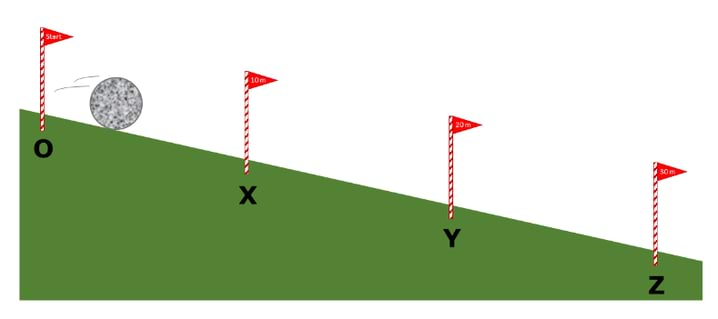Learning focus: | A resultant force on an object can cause it to speed up or slow down, depending on the direction of the force. |
Observable learning outcome: | Describe how the speed of an object changes throughout the time that a resultant force is acting on it. |
Question type: | Diagnostic, confidence grid |
Key words: | Speed, acceleration |
Children below the age of about 11 tend to think of speed change as a short intensive effort, followed by constant speed. In a study (Hast and Howe, 2013), children observed a ball falling in free fall, accelerating down a ramp and rolling along a flat surface. In each case they were asked to predict whether the ball was speeding up, slowing down or travelling at a steady speed through the second half of each motion. For the accelerating balls the thirty-six 11-year-olds involved in the study made correct predictions only a little more often than they would have done by chance.
In a study by Dykstra and Sweet (2009) of 9- to 13-year-olds in the United States (n=103), it was found that the majority of students (aged 11-12) described the motion of an object as a snapshot of its direction and speed (moving quickly this way or slowly that way). Just 11% of this group gave a dynamic description of an accelerating object, in free fall or rolling down a ramp, in terms of a changing speed.
This question investigates students’ understanding of how the speed of an object changes throughout the time that a resultant force is acting on it.
Students should complete the confidence grid individually. This could be a pencil and paper exercise, or you could use an electronic ‘voting system’ or mini white boards and the PowerPoint presentation.
If there is a range of answers, you may choose to respond through structured class discussion. Ask one student to explain why they gave the answer they did; ask another student to explain why they agree with them; ask another to explain why they disagree, and so on. This sort of discussion gives students the opportunity to explore their thinking and for you to really understand their learning needs.
Differentiation
You may choose to read the questions to the class, so that everyone can focus on the science. In some situations it may be more appropriate for a teaching assistant to read for one or two students.
Märgi igas reas sobivaim vastus.
| A | Kivi kiirus punktis X on suurem, kui punktis O | |
| B | Kivi kiirus punktis Y on suurem, kui punktis X | |
| C | Kivi kiirus punktis Z on suurem, kui punktis Y | |
| D | Kivi kiirus punktis Z on suurem, kui punktis O |
Hast and Howe (2013) found that students almost always recognise an increase in speed from the start to any subsequent point along the path. By contrast they found that only just over half of 11-year-olds correctly predicted that speed continued to increase throughout the whole motion.
It is likely that significant numbers of students will be right for statements A and D, and wrong (or uncertain) for statements B and C.
If students have misunderstandings about how the speed of an object changes throughout the time that a resultant force is acting on it, it can help to give students the opportunity to describe and justify what they think will happen, before observing a practical demonstration in order to confirm what really does happen. Working in pairs or small groups can encourage social construction of understanding through dialogue. A further opportunity for each student to correct or improve their explanation will allow them to consolidate their learning.
The following BEST ‘response activity’ could be used in this way in follow-up to this diagnostic question:
- Response activity: Steady force
The Development of Children's Understanding of Speed Change: A Contributing Factor Towards Commonsense Theories of Motion
Hast, M. and Howe, C. (2013). The Development of Children's Understanding of Speed Change: A Contributing Factor Towards Commonsense Theories of Motion. Journal of Science Education and Technology, 22, 337-350.
